Support of excellence
UND flight operations, maintenance technicians continue to meet demand of nation’s top flight school

Dan Kasowski is hard-pressed to recall how many flight hours UND Aviation logged 40 years ago, but he can remember the summers being quiet.
Now, from his office situated between the Bravo and Charlie ramps at Grand Forks International Airport, summers could best be described as a dull roar.
“Right now, we don’t miss a beat,” the director of maintenance for UND Aviation remarked. “We don’t have what someone would call ‘slow days.’”
Of course, slow days are all too possible for UND’s aviators. North Dakota’s weather can be unforgiving. But in rain, snow or shine, the maintenance facilities always run at capacity – 18 hours a day, seven days a week.
Keeping the pace
In Kasowski’s four decades at the airport, he’s witnessed the growth of UND as the nation’s premier flight school. He oversees the departments currently responsible for just over 100 airplanes and helicopters stored every night in 11 hangars at GFK, as well as the 40 aircraft at UND’s Phoenix Flight Training Center and the flight simulators on main campus. It’s an all-encompassing maintenance operation.

When he started, he was one of two full-time mechanics. Now he has 25 certified aircraft technicians bolstered by eight full-time support staff, and a rigorous inspection process to boot.
“We are an FAA Part 145 Repair Station, which means we have a separate quality control department – a double set of eyes on everything we do,” Kasowski said, describing the stages of an airplane going through maintenance, routine or otherwise. The operation is made up of aircraft technicians, inventory control, quality control, avionics, production control and the wash and detail bay. As for inventory, Kasowski says the latest tallies add up to $1.6 million in aircraft parts stored on-site.
Just before going onto the floor of the maintenance hangar, a marker board showed the past week of daily flight hours. Nothing that week dipped below 500, which means both shifts of mechanics had their work cut out for them.
“If you add up all of those hours and divide by 60, our inspection interval, that’s how many inspections we have to do to make sure we keep up,” Clark Gebhard said. “We’re usually seeing six to ten aircraft a day.”
Gebhard has been a shift supervisor for five years out of his 15 at the airport, but he does as much as he can to minimize the title. He’s not much different from anyone else on the floor, he says – just a few more responsibilities. As he describes the ins and outs of his job, he’s moving station to station to help the other six mechanics complete their inspections. He also answers a radio call by hopping in the “mobile maintenance” van, driving onto the ramp to get air in a plane’s tire and inspect the alignment of its wheel assembly.
“We keep up with this pace because we know our goal is to help out the student, and to get them in a safe, airworthy airplane at a reasonable cost,” he said. “We’re the Jiffy Lube of aviation. We’re doing a lot of oil changes and pushing things through, but we’re able to sell airplanes at a high return when we’re done with them at 8,000 hours or more.”
The best way to imagine this is selling a car at 200,000 miles, Gebhard says. Every eight years, the UND fleet is evaluated, and it’s currently transitioning from the high-wing Cessna 172S to the Piper Archer. With the amount of care each plane receives in its lifespan, and the diligence in tracking and recording its maintenance, it still has plenty to give to its next owner.

Safe and efficient
The daily process Gebhard helps lead is one based on typical aviation inspection standards, but hyper-specialized for both the aircraft and the workforce maintaining them. For aircraft used for hire, an inspection is required every 100 hours of flight. An engine needs an oil change every 50 hours. At UND, to keep enough planes ready for student demand and also meet these figures, the inspections are split into four phases.
“If we were doing 100-hour inspections, you’d be looking at two or three days of that plane being down. One person is tied up on that, which doesn’t work,” Gebhard said. “When we split it into four inspections every 60 hours, we’re able to look at things just the same and more often. It’s more efficient when a technician is able to start an inspection and finish it that same day.”
Each phase examines a separate aspect, but also incorporates a thorough pre-flight check of the entire aircraft. Phase one is the interior of the plane, everything from seat belts to instruments. Phase two is engine detail. Phase three looks at the landing gear and wings. The final phase is another inspection of the engine.
“By doing that, we’re doing compressions on the engine like you would in a 100-hour check-up,” Gebhard says, adding that every UND aircraft comes through at least once a month. “We’ve been able to develop our own efficient inspection system that’s approved by the FAA. It works really well for us.”
Pride in flight
Kasowski, in the halls of the maintenance building, points to a wall that’s running out of space. Every year, UND receives a Certificate of Excellence from the FAA for having 100 percent participation in training. He’s proud of the working relationship he has with the industry’s regulatory body, as well as the dedication to continued staff education
“There’s pride in being the best flight school,” Kasowski said, highlighting everything from the combined years of staff experience to the whiteness of the hangar floors. “We have pride in our facility, in the condition of our airplanes. Our safety record is something we don’t talk about enough – I don’t remember the last time there was a maintenance-related incident.”
Gebhard also takes a moment to recognize the high levels of safety and compliance adhered to by maintenance staff, even in the daily grind of keeping up with demand.
“We’re part of a prestigious institution,” he said. “We may not be as seen as the other portions, but we’re an integral part of it. We’ll always have new instructors teaching new pilots how to fly, but you can always count on them having a safe plane.”

By the numbers
Kasowski, Gebhard and all of maintenance play into the larger team effort of flight operations at UND. From dispatching to managing the flight line, flight operations maintains some impressive stat lines.
For starters, UND contributes to 90 percent of GFK’s traffic, making its control tower one of the busiest in the nation. The University logged over 111,000 flight hours in the 2018-19 academic year. The 19-member line team fuels at least 55,000 aircraft in a given year, handling over 2.4 million gallons of fuel and 4,500 quarts of oil.
In the maintenance hangar, Gebhard and fellow technicians inspected 1,210 aircraft in 2018, requisitioning over 43,000 aircraft parts. They replaced 494 tires, 1,320 oil filters and changed 567 spark plugs as they generated 33,164 work hours maintaining UND’s fleet.
Regardless of how those numbers might change down the road, Kasowski figures UND is ready for the challenge.
“We do a great job of forecasting because we have experience and knowledge throughout flight operations,” he said. “The interconnection between the skill sets and years of experience we have out here is what has made us successful.”



